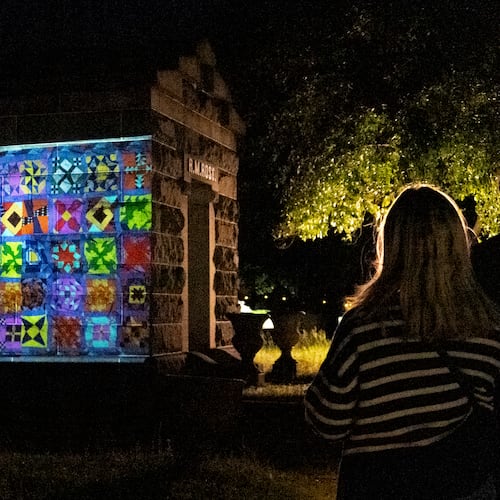If you’re talking about seismic events in American history, like the civil rights movement and the Civil War, then its time to unearth William Faulkner’s quote: “The past is never dead. It’s not even past.”
I thought of this Saturday as the bronze statue of civil rights hero John Lewis was being unveiled on Decatur Square.
With the yank of a rope, a shroud fell from the 12-foot statue showing the late Congressman, eyes closed, hands over his heart, no doubt pondering virtuous, courageous and noble thoughts.
It replaces a granite obelisk that for a century commemorated those who “knew no law of life but loyalty and truth and civic faith, and to these virtues they consecrated their strength.”
That 30-foot structure, erected by the United Daughters of the Confederacy in 1908, was removed late at night in June 2020 before a cheering throng after a DeKalb County judge deemed it a “public nuisance.”
The Confederate obelisk now lays on its side, covered in a tarp, in a county storage area in south Dekalb. Its pedestal, also wrapped in a tarp, sits along side. “Defund the police” is scribbled on it.
DeKalb officials contend they’ve tried to follow state law, which protects Rebel remembrances. They say they’d like to give the monument to another entity so it can stand again. But no takers.
The obelisk was erected in an era when monuments sanitized white supremacy in the South and the myth of “The Lost Cause” was born.
Its removal demonstrates the acceleration of public opinion on issues of the day — and, yes, history, too.
In 2017, when there were rumblings about Confederate monuments, a PBS poll found Americans more than 2-to-1 opposed to removal. Even Black people were evenly split, with 44% saying “get rid of ‘em” and 40% saying “leave them be.”
At the time, I stood by the obelisk and at Stone Mountain Park and interviewed 16 Black people. Only two were steadfast in wanting such monuments’ removed, although most of the others sure didn’t like them.
Just three years later, on Juneteenth 2020, a chanting crowd cheered as a crane hoisted the monument from its moorings.
What changed? George Floyd had been killed just weeks earlier and protesters were in the streets. Years of Donald Trump had also provided motivation.
Credit: DeKalb County History Center
Credit: DeKalb County History Center
At Saturday’s ceremony, DeKalb CEO Michael Thurmond, a published historian himself, spoke of the monument’s back story.
He gave a nod to retired Judge Clarence Seeliger, who ordered the obelisk’s removal after the city of Decatur sued DeKalb to get rid of it. (The county largely didn’t put up a legal defense.)
Thurmond noted that Seeliger was historic in his own right: In 1980, he defeated Judge J. Oscar Mitchell, who notoriously sent Martin Luther King Jr. to prison on a probation violation charge that stemmed from a traffic ticket and a sit-in arrest.
I couldn’t hear Thurmond at Saturday’s event, so I called him. He joked the effort was “historic” because DeKalb and Decatur worked together.
Credit: Steve Schaefer /
Credit: Steve Schaefer /
“The obelisk was an object of conflict and consternation and (the statue) transformed it into a unifying moment for DeKalb County,” he said.
He added, “History always casts the final ballot.”
I called Seeliger, who couldn’t attend because of recent knee replacement. He made the “public nuisance” ruling, he said, because he feared protesters and counter-protestors might clash and “it might end up like Charlottesville,” referring to the 2017 white nationalist rally in Virginia that ended in a death.
The judge reminded me that in the 1980s he held up the proposed highway that was to be rammed through several Atlanta neighborhoods. The powers that be — including former President Jimmy Carter, then-Atlanta Mayor Andrew Young and the DOT — supported it.
John Lewis back then was an Atlanta City Councilman who earned political street cred by working with civic associations to fight the road. A smaller, compromise roadway running next to the Carter Library was ultimately built.
It was later renamed the John Lewis Freedom Parkway.
In fact, Lewis’s road-busting ways was a factor that helped him squeak out a surprise runoff victory in 1986 to the Congressional seat that he held for nearly 34 years.
In 1986, Lewis, faced off against another civil rights leader, the urbane Julian Bond, who was supported by the local Black power structure. Bond, who at the time was more of a national figure, drew support from big-time Black mayors, U.S. Sen. Ted Kennedy and even Simon and Garfunkel.
Lewis touted himself as a workhorse. And although Bond was supported 2-to-1 by Atlanta’s Black voters, Lewis did even better with whites, forcing a runoff, which he ultimately won. It was a bitter, brutal battle and showed Lewis could go for the jugular when needed.
After the loss, Bond’s campaign manager assessed white voters, saying: “I just think they saw Julian as being too Black.”
In Congress, Lewis carved out a national legacy, and his memory has eclipsed that of his long-ago rival and one-time friend. In fact, the Decatur statue is Lewis’ second in Atlanta, along with a plaza, a road and a school named for him.
There are no such remembrances here for Bond.
A century from now, like passersby once glanced at the obelisk, future citizens will look at his statue, see the name of the long-dead Lewis and ponder the one-word epithet: “Empathy”.
About the Author
Keep Reading
The Latest
Featured






